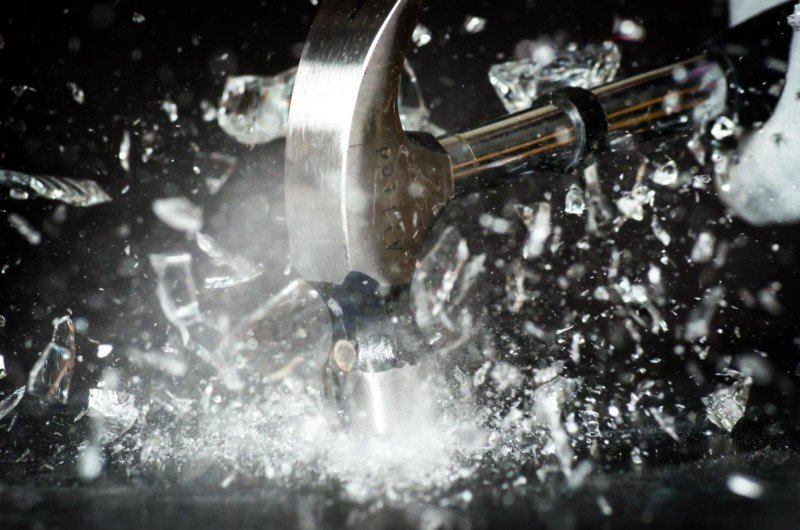There’s an old joke where you ask someone what’s the most important thing about comedy. When they get to about the word “important,” you interrupt them and say, “Timing!” Perhaps the same thing can be said for photography. [Ted Kinsman’s] students at the Rochester Institute of Technology would probably agree. They built an Arduino-based rig to do inexpensive stop action photography.
As Arduino projects go, it isn’t very sophisticated. The circuit contains a sound detection module and an optoisolator. The code would easily fit on a piece of notebook paper. When a loud sound occurs, the Arduino triggers the flash. Simple enough, but the resulting pictures are amazing. It also looks like a lot of fun to destroy perfectly good things in the name of art.
If you are interested in photography, there are enough photos of their setup to give you some ideas about lighting, reflectors, and camera angles. If you are not a photography fan, you still should check out the post to see more of the pictures the students took.
Interestingly, [Dr. Harold Edgerton] at MIT pioneered this technique starting back in 1937 and you’ve probably seen some of his famous photographs like the bullet through the apple or the milk drop crown. He used the same techniques to take photographs of the atomic bomb tests in the 1950s and 1960s.
You don’t have to use sound as a trigger, by the way. We’ve seen lasers do the trick. And while the Rochester group’s build was simple, we’ve seen some even more bare-bones.
















Soon we’ll be at the point we can take pictures of fast-reaction chemical processes.
“The first laser pulses were produced in May 2017; the facility is scheduled to start user operation in September 2017”
– https://en.wikipedia.org/wiki/European_x-ray_free_electron_laser
This is expected to have a huge impact on material science and drug research.
We already can. Look more into Femtosecond nanocrystallography using X-Ray Lasers for membrane protein structure determination. Published 6 years ago. It’s really coming along. We are now imaging entire proteins changes at the individual molecule and femtosecond time scale.
https://www.ncbi.nlm.nih.gov/pmc/articles/PMC3413407/
Did that trick 35 years ago with a small piece of aluminum foil, an air-pressure gun and light bulbs, apples, tomatoes, balloons,… the only electronics involved were two resistors, a capacitor, a small battery and a thyristor for triggering the flash (yes, just open the camera shutter and trigger the flash when the bullet destroys the foil bridge – we assembled the stuff in a completely dark room)
Forgot to mention that they had to use a computer to actually fire the flashes, because they couldn’t figure out how to fire the speedlites from the arduino.
Haha, the first comment on their website mentions that they could have used a 555…
They actually didn’t. In flash terminology, PC is the connection to remotely trigger the flash. They used an optoisolator to fire the flash via its PC connection without exposing potentially dangerous voltages to the Arduino.
I was thinking just today about the march of software into everything (in particular automotive) and was wondering how much we throw software at that could be done physically ( i.e. With hardware – electronic or mechanically and this is a classic example.
If your learning programming and this is an exercise in programming that’s great but are we over doing the software at the expense of hardware
“We”?
Yeah, “who we white man?” (in the famous words of Tonto talking to the Lone Ranger.) There certainly is this urge among “some people” to throw an arduino or some ARM single board computer at every problem these days.
Birth control?
If you asked my wife she would probably say that it’s working for that too – albeit indirectly.
Because fine tuning or adjusting is trivial in software, in hardware it could mean unsoldering caps or resistors, filing away material, adjusting preload, etc. If you can throw software at it then why not?
Software also tends to be less expensive to manufacture.
Unless one’s talking about government projects, and their cost overruns.
I made a thing using an ESP12 that controls four flash and the camera shutter along with a solenoid drop and a trigger on laser beam interrupt. The big problem is that DSLR cameras take between 100 and 300 ms from getting the trigger signal to actually triggering the shutter whereas the flashes go off almost instantaneously. For the most part the shutter lag is pretty constant unless you have a Canon and in that case they are all over the place.
This is three flash guns, one shutter. You get this effect because it is a focal plane shutter: http://roughtop.co.uk/john/IMG_9279.JPG
These are also taken with it.
http://roughtop.co.uk/john/
This one is from a macro rail I made also using the ESP12: http://roughtop.co.uk/john/eye.jpg
“Knock, knock”
“Who’s there?”
“Interrupting Cow.”
“Interrup” – “MOOOOOOOO”
I had a friend who’s kid loved an alternative to that joke.
I was going to type it, but it just doesn’t do it justice so…
https://www.youtube.com/watch?v=WqlE520OsjU
Well if you want me to understand it you are going to have to type it because I can’t tell what they are saying. :)